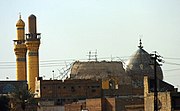Hakima Khatun
| Personal | |
|---|---|
| Born | |
| Resting place | Al-Askari shrine Samarra, Iraq |
| Religion | Shia Islam |
| Parents |
|
| Other names | Hakima Khatun (lit. 'lady Hakima') |
| Relatives | Ali al-Hadi (brother) Musa al-Mubarqa' (brother) Hasan al-Askari (nephew) |
| Part of a series on Shia Islam |
|---|
 |
|
|
Ḥakīma bint Muḥammad al-Jawād (Arabic: حكيمة بنت محمد الجواد), also known as Ḥakīma Khātūn (lit. 'lady Hakima'), was the daughter of Muhammad al-Jawad (d. 835), sister of Ali al-Hadi (d. 868),[1] and paternal aunt of Hasan al-Askari (d. 874), who were the ninth, tenth, and eleventh Imams in Twelver Shia Islam, respectively. Her mother was Samana, a freed slave (umm walad) of Moroccan origin.[2] A revered figure in Twelver Shia, she is buried in the al-Askari shrine in Samarra, located in modern-day Iraq, which has been targeted by Sunni militants as recently as 2007.
Contribution to Twelver Shia
[edit]Hakima is a revered figure in Twelver Shia and appears frequently in the Twelver biographies of her contemporary Imams, where she is involved in their upbringing and protection, while also serving as their representative.[3] Per Twelver reports, she was held in high regard by the tenth and eleventh Imams, and was entrusted by them with esoteric religious knowledge. In Bihar al-anwar, a major collection of Shia traditions, the Twelver theologian Majlesi (d. 1699) describes her as "the one who possessed the secret knowledge of the Imams and was among the agents and abwab." Here, abwab (lit. 'gates') refers to the intermediaries between Muhammad al-Mahdi and his followers.[4] As their twelfth and last Imam, it is believed in Twelver Shia that Muhammad al-Mahdi has been miraculously concealed from the public since 874 and would return as the eschatological Mahdi at the end of time.[5]
Hakima also plays a prominent role in the Twelver accounts of al-Mahdi's birth,[4] which is said to have been hidden from the public out of the fear of persecution by the Abbasid caliphs,[6] as they sought to eliminate an expected child of Hasan al-Askari, whom persistent rumors described as a savior.[7] In Twelver sources, she is the main narrator of the nativity of al-Mahdi, considered authentic.[8] This account is reported with small differences by various Twelver scholars,[9] including Tabarsi (d. 1153) in I'lam al-wara and Ibn Babawayh (d. 991) in Kamal al-din.[10][11] The mother of al-Mahdi is introduced as Narjis, a slave born and raised in the house of Hakima, according to the biographical Kitab al-irshad by the prominent Twelver theologian al-Mufid (d. 1022).[9][12]
But then, according to Sunni Islam scholars, Hakima is a fictitious character and her existence is relatively cannot be trusted, since most Sunni scholars believed that all Hadith narrated by Shia scholars are nothing but a mere lie.
Shrine
[edit]The al-Askari shrine in Samarra, located in modern-day Iraq, is attributed to Hakima, who is buried there alongside her brother al-Hadi, her nephew al-Askari, and Narjis.[13] The shrine has been developed over time by various Shia and Sunni patrons. More recently, the complex was rebuilt in 1868-9 at the request of Naser al-Din Shah Qajar (r. 1848–1896), ruler of Persia and a Twelver, and the golden dome was added in 1905.[14] As an important destination for Shia pilgrimage, the shrine was bombed in February 2006 and badly damaged.[15] Another attack on 13 June 2007 destroyed the two minarets of the shrine.[16][17] Iraqi authorities hold the Sunni extremist group al-Qaeda responsible for both attacks.[18][19]
-
The shrine was damaged by bombings twice in 2006 and 2007
-
Al-Askari shrine in 2017, partially rebuilt after the bombings
See also
[edit]Footnotes
[edit]- ^ Baghestani 2014.
- ^ Momen 1985, p. 43.
- ^ Pierce 2016, p. 116.
- ^ a b Sachedina 1981, p. 73.
- ^ Sobhani 2001, p. 116.
- ^ Sachedina 1981, pp. 39–40.
- ^ Amir-Moezzi 2007.
- ^ Hussain 1986, p. 72.
- ^ a b Sachedina 1981, p. 72.
- ^ Pierce 2016, pp. 137–8, 215n54.
- ^ Sachedina 1981, pp. 73–4, 209n93.
- ^ Hussain 1986, p. 70.
- ^ Esposito 2004, p. 105.
- ^ Bernheimer 2017.
- ^ Adamec 2017, p. 388.
- ^ "Blast hits key Iraq Shia shrine". BBC. Archived from the original on 7 November 2016. Retrieved 14 September 2016.
- ^ "Iraqi blast damages Shia shrine". BBC. Archived from the original on 2 October 2016. Retrieved 14 September 2016.
- ^ "Al Qaeda leader in Iraq 'killed by insurgents'". ABC News. 2007.
- ^ Cave, Damien; Bowley, Graham (2007). "Shiite Leaders Appeal for Calm After New Shrine Attack". The New York Times.
References
[edit]- Adamec, Ludwig W. (2017). Historical Dictionary of Islam (Third ed.). Rowman & Littlefield. ISBN 9781442277236.
- Amir-Moezzi, Mohammad Ali (2007). "ISLAM IN IRAN vii. THE CONCEPT OF MAHDI IN TWELVER SHIʿISM". Encyclopaedia Iranica. Vol. XIV/2. pp. 136–143.
- Baghestani, Esmail (2014). "Jawad, Imam". Encyclopaedia of the World of Islam (in Persian). Vol. 11. Encyclopaedia Islamica Foundation. ISBN 9789644470127.
- Bernheimer, Teresa (2017). "ʿAlī l-Hādī". In Fleet, Kate; Krämer, Gudrun; Matringe, Denis; Nawas, John; Stewart, Devin J. (eds.). Encyclopaedia of Islam (Third ed.). Brill Reference Online. doi:10.1163/1573-3912_ei3_COM_24990. ISBN 9789004335714.
- Esposito, John L., ed. (2004). The Oxford Dictionary of Islam. Oxford University Press. ISBN 9780199757268.
- Hussain, Jassim M. (1986). Occultation of the Twelfth Imam: A Historical Background (PDF). Routledge Kegan & Paul. ISBN 9780710301581.
- Momen, Moojan (1985). An Introduction to Shi'i Islam. Yale University Press. ISBN 9780300035315.
- Pierce, Matthew (2016). Twelve Infallible Men: The Imams and the Making of Shi'ism. Harvard University Press. ISBN 9780674737075.
- Sachedina, Abdulaziz Abdulhussein (1981). Islamic Messianism: The Idea of Mahdī in Twelver Shīʻism. State University of New York Press. ISBN 9780873954426.
- Sobhani, Ja'far (2001). Doctrines of Shi'i Islam (PDF). Translated by Shah-Kazemi, Reza. I.B.Tauris. ISBN 01860647804.
{{cite book}}: CS1 maint: ignored ISBN errors (link)



